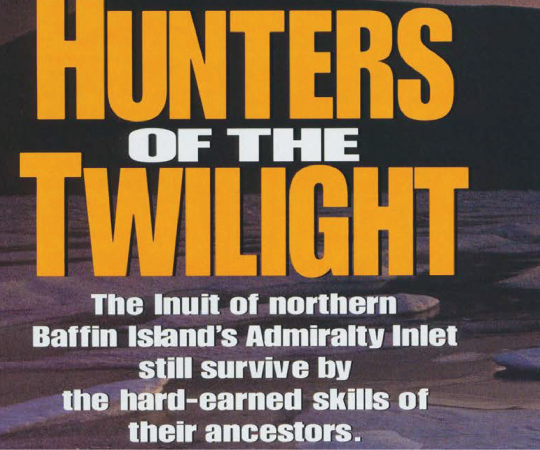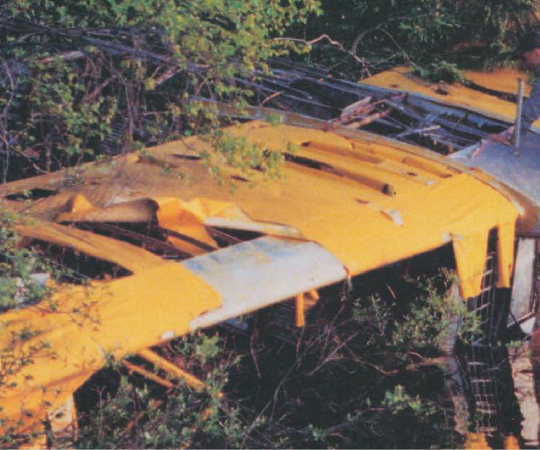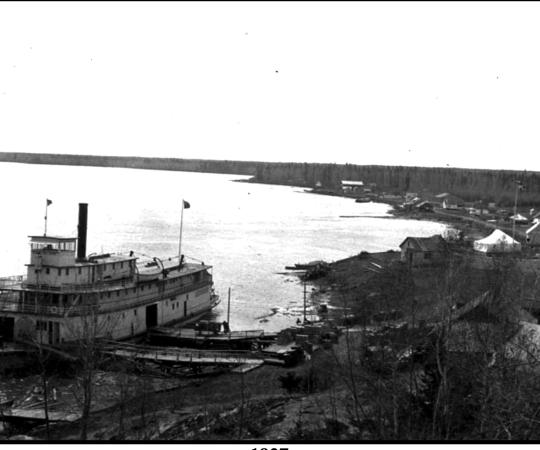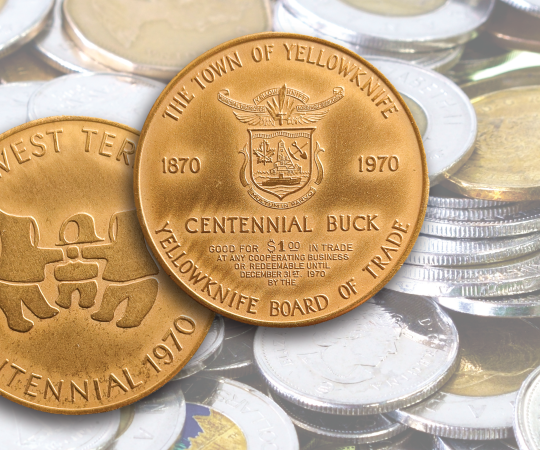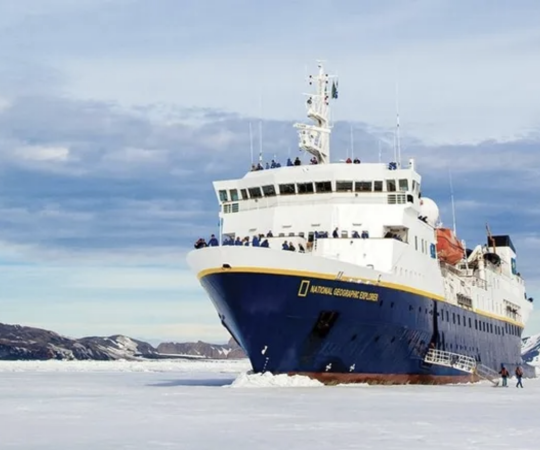“If we’re willing to trade infinity for the finite, as a species, we’re already dead.” —Chief Dana Tizya-Tramm, Vuntut Gwitchin First Nation
The Bell River starts about 90 kilometres from Old Crow along the Porcupine River. On a new snowmachine, that trip burns five gallons of fuel, hunter Jason van Fleet tells me. A few years back, he got 12 caribou at that spot with elder and respected bushman Stan Njootli Sr.
Van Fleet is the executive director of the North Yukon Renewable Resources Council in Old Crow and he loves to talk trapping. His office is crowded with stacks of papers and pelts. Down the hall, in the community’s cultural centre, are exhibits devoted to the history of the Vuntut Gwitchin and their connection to caribou. He points to a photo from his hunt with Njootli on the wall, taken shortly after their return.
The two men had left for Bell River at 6 a.m. By lunchtime they had their caribou. It took longer than van Fleet expected to skin the animals and cut them up for the trip back. But it was a warm spring day, so they felt no need to hurry. “We were just sitting there in sweaters, processing these caribou, just Stan and I,” he says. It was dinnertime when they started back for town, but Njootli’s machine soon broke down. It couldn’t be repaired there, so they left it for the night. Njootli hopped on and drove van Fleet’s sled as a dogmusher does—standing up, no matter the speed—while van Fleet sat behind, barely keeping his eyes open after the long day. Roughly 50 kilometres from town, they decided to stop for the night at the first cabin they came across. Njootli walked around back and found a key.
After a good night’s sleep, they awoke to the sound of two other hunters chatting. When you run into other people on the river, van Fleet says, you always stop and chat with them. It’s not about rushing out there. “The elders will tell you, you can’t just travel up the river and shoot something. You have to stop, camp, boil water, make tea and wait.” The caribou could be just over the high banks where you can’t see them. You have to take your time. There is a way of hunting that’s worked here for thousands of years. The technology and machinery used to hunt caribou may have changed but the traditions, for the most part, have not.
But in the last year, the stakes are higher than ever in the three decades-long battle waged by various U.S. governments to open up pristine northern Alaska lands for development, which may put the very future of the caribou at risk. In December 2017, the Trump administration signed a bill to open a section of the Arctic National Wildlife Refuge (ANWR) in Alaska for oil and gas exploration. Any development there will have consequences for the Porcupine caribou herd, which migrates through Alaska, the Yukon and Northwest Territories each year.
Caribou are renewable. Oil is not. In Old Crow today, people rely on both. As the lone Yukon community not connected to the highway grid, goods arrive—and people come and go—on planes. The Vuntut Gwitchin government has at times built an ice road to bring in large shipments for construction projects. Nonetheless, this all requires fossil fuels. Oil heats many homes in town and diesel is also used to generate electricity for this off-grid community. Of course, it hasn’t always been this way: the Vuntut Gwitchin sustained themselves on caribou long before outboard motors, trucks and planes.
A threat to the Porcupine herd is still a threat to the livelihoods of Gwitchin in Old Crow. Fewer caribou will mean flying in more food to the community. It will mean using more fuel to reach the scattered and far-off caribou that remain. And most oil jobs and economic spin-offs will stay in Alaska.
This is what the choice of oil over caribou looks like in Old Crow. Newly elected Vuntut Gwitchin First Nation Chief Dana Tizya-Tramm puts it more directly: “If we’re willing to trade infinity for the finite, as a species, we’re already dead.”

The Porcupine caribou herd is the healthiest in Canada. It has doubled in size to more than 200,000 animals since a 2001 count. There are a few theories for this increase, but no concrete explanations. Mike Suitor, a caribou biologist with the Yukon government, says the varying landscapes this herd calls home—soil-rich plains with abundant vegetation, along with mountains that break up harsh weather systems and offer protection from predators and mosquitoes—help it thrive.
From late May to early July, the cows cluster across the coastal plains of Alaska, known as the 1002 lands, to calve. They stay there for the critical first four to six weeks of their calves’ lives. “You can set your watch by it,” says Suitor. Through the summer and fall, the cows and bulls spread out across their traditional grounds through the northern Yukon and into the NWT, almost as far south as the Yukon River, passing communities like Old Crow on their way. The migrating animals will return in the spring on their way to the calving grounds.
Caribou have been on this land for more than a million years, says Brandon Kyikavichik, a Vuntut Gwitchin heritage interpreter. He’s young and determined to know what people before him did. He translates stories and documents from the Gwitchin language and gathers information from elders. So much of that history is tied to the Porcupine caribou. “We’re just guests in their home and they’ve been treating us pretty darn good for thousands of years,” he says. The Vuntut Gwitchin crafted tools, created artwork and even toys from caribou bones, hooves and cartilage. “We took their furs and we built our shelters with them and we sewed all our clothes,” says Kyikavichik. “I think that we have earned every right to be able to live with them and coexist with them the way we have for thousands of years now.”
Signs of caribou are everywhere in Old Crow. Antler racks are affixed to the roofs of sheds and homes. Outside Bruce Charlie’s late mother’s house caribou hooves hang to dry in bunches from trees like garlic in a root cellar. They keep for a long time, says Charlie, a former chief. Back when caribou were scarce, they’d boil the hoof for about two days to soften it enough to eat. It tastes good, says Charlie. On the back of his shirt is a glittered screen-print of a caribou with a massive rack.

Toward the other end of town, overlooking the shore of the Porcupine River, Brenda Frost butchers a caribou on the table inside her shed. Flanks hang behind her, draped over a wooden beam while she wields the cleaver, portioning off different cuts into bags and cardboard boxes. She offers me drymeat with butter and a small bowl of the marrow carved out from the caribou bones. It’s so rich and salty it makes the butter seem bland.
Frost will share the caribou with her family: She has two grandsons and a sister in Whitehorse who crave this traditional food. “It’s precious,” she says. “It’s like gold.” She hands me a bag of fresh stewing meat to cook up later. If there are no more caribou, she asks, what will people eat?
It’s certainly a staple of the diet in Old Crow. There’s a grocery store in town, but the Co-op suffers the same ills as most Northern retailers. On a Wednesday in September, the produce shelves are bare, save for a carton of red apples. Dairy and fresh meat are also quickly depleting. Manager Greg Toner posts a sign in the window, apologizing to customers and explaining his shipment has been delayed for the second week running. The truck to Whitehorse came in late, missed the flight to Old Crow and then there was limited space on the plane for all of the supplies.
The high cost of food and unpredictability at the grocery store helps explain why country food accounts for roughly half of most diets in Old Crow. “We try not to waste any,” says Frost. “We can’t. It’s our food for the winter until we can get caribou again in the spring.” But more than that, the Vuntut Gwitchin have always eaten caribou. Many people prefer the taste of caribou to moose. “Christ, I don’t want to eat muskox,” Frost says facetiously.
One of the most photographed spots in town is a pole decorated with caribou antlers outside Stephen Frost’s house. About 40 years ago, Stephen put a rack up on the pole after one of his sons got his first caribou. When his other son got a caribou, he put that rack up. It continued, and continues still. A set of antlers was added to the top this fall. ˚
A decade ago, thousands of caribou would rush across the river at once, just outside of town. Today, a flurry of ATVs arrive at the beach to load up boats as word spreads that some caribou were tracked 70 kilometres upriver. Boats have been coming and going for over a week now, but it’s been a difficult and expensive hunt considering the amount of fuel needed to reach the herd. The Vuntut Gwitchin First Nation subsidizes gas because it would be far too costly otherwise. (It’s about twice the cost per litre than it is in Whitehorse.)
Though the Porcupine herd is in good shape compared to other herds in the North, its habits are changing. Some elders, like Stephen Frost, recognize several factors at play for this, including the way they’re hunted these days. “Everybody is different,” he says, “but sometimes they kill too much. The caribou have been chased too much by snowmachines, by boats. They get scared.”
Still, events outside the community, spurred on by faraway decision-makers who know nothing about life in Old Crow, could determine the fate of the caribou the Vuntut Gwitchin depend on.

Two days after Christmas in 2017, U.S. President Donald Trump, sitting in the Oval Office, held up a document for photographers with his Sharpied signature scrawled across it. “We’re opening up ANWR to drilling,” he told reporters. “They’ve tried to do that for 40 years—they even tried to get that during the Reagan administration and they couldn’t get that.”
With his typical modesty, Trump not only opened part of the Arctic National Wildlife Refuge to drilling, but demanded it be drilled. The bill requires no less than two lease sales occur within 10 years of the bill’s assent, with the first of those lease sales mandated within the first four years. “When he signed the Tax Cuts and Jobs Act Bill, he mentioned ANWR specifically,” recalls Tizya-Tramm, who was then a Vuntut Gwitchin councillor in charge of the caribou file. “Watching that as a young Indigenous person, that signature signed the fate of my people.”
The bill renewed interest in the 1002 lands—1.5-million acres of coastal land in northeastern Alaska that were put aside when ANWR was established in 1980 under the Alaska National Interest Lands Conservation Act. Though the rest of the refuge was protected from development, the act deferred any decision to develop or protect the 1002 lands due to their oil potential. Instead, it ordered studies of its oil and gas reserves, and fish and wildlife habitats so future decision-makers could understand how development of the former might affect the latter.
A new seismic program has been proposed for a more accurate read of the oil-bearing potential of these lands. (Seismic studies have been recurring since 1981.) This testing troubles opponents, as it involves 30-ton trucks pounding at the ground to take geological readings and it leaves behind scars on the landscape, disturbing surrounding wildlife.
For now, it’s unclear how economical oil extraction would be in the Arctic National Wildlife Refuge. Only one well has been drilled there, back in 1986. It cost $40,000 and Chevron, the leaseholder, quickly capped well K1C-1 and never touched it again. There’s reported to be 7.7 billion barrels of technically recoverable oil in the 1002 lands and seven trillion cubic feet of natural gas. But due to the high costs of operating in this remote area, it is extremely unlikely that all of the technically recoverable resources would be extracted. Rather, according to a draft environmental impact statement, roughly half of the oil (3.4 billion barrels) is expected to be recovered by 2050. Estimates for gas recovery range from none, to nearly all.
A treaty between Canada and the U.S., signed in 1987, was conceived to protect the Porcupine caribou herd, which moves across the international border each year. It recognizes the importance of conserving calving, post-calving, migration, wintering and insect-relief habitat. It also recommends signatories ensure the herd, its habitat and the interests of users of the herd “are given effective consideration in evaluating proposed activities within the range of the herd.”
Tizya-Tramm stood in front of the Department of Interior on Capitol Hill just after the Tax Cuts and Jobs Act was first introduced. He was given five minutes to sum up 40,000 years of oral history connecting the caribou to his people. All the while, a top official with the department tapped away at his phone. This is not consultation, says Tizya-Tramm. And he’s said this to the department too.
The 1987 treaty is non-binding and has no statute for conflict resolution, so it offers little help in this way. “That was an agreement we signed to conserve caribou habitat and protect the critical state of the environment at that time,” says Pauline Frost, Vuntut Gwitchin MLA and the Yukon’s environment minister. She travelled to the United States 20 years ago to advocate for the caribou. “We were not seeing the U.S. living up to the agreement they signed off on in good faith.”
By 1989 a bill to open the 1002 lands to drilling was on its way through the U.S. Senate when the Exxon Valdez spill spooked proponents and effectively stopped the process. Again in 1996, the senate voted to allow drilling, which led to a veto from then-president Bill Clinton. The political climate in the U.S. was right at the time to push for protections, says Minister Frost. “As a small Northern community, we couldn’t really go and influence the monstrosity of the United States government,” she says. “It would be impossible.” Instead, they went to environmental groups and universities to spread awareness of the threat to caribou. They lobbied politicians and tried to make it an election issue.
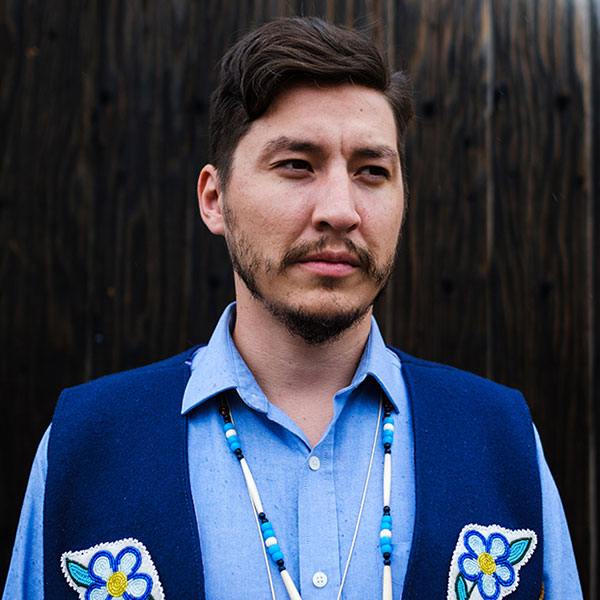
Leadership in Old Crow at the time, which included her mother Alice Frost, was focussed on teaching youth about their culture, the importance of the caribou and the fight to protect them. Minister Frost’s grandmother taught her about the resources the land provides that allows for their very existence. She took that knowledge with her on her travels to Washington. “I did what I felt was speaking from my heart about what I knew as the truth at the time, and that was to protect the way of life of the Gwitchin people of the North.”
This work is still critical today, and as a minister she has a louder voice and much larger platform than before. “It’s more sensitive now than ever before because we have this United States government that’s adamant about drilling in the Arctic refuge, despite the international agreement, despite what we know to be the cumulative effects on the environment of climate change and drilling on the people and the caribou calving grounds,” she says, adding the governments of Canada and the Northwest Territories are both in step.
The people of Old Crow already have an idea of how things will look if they can’t depend on the caribou. By mid-September, hunters would normally have 100 animals, van Fleet says. Last September, when caribou were found further away from the community, they had around 30.
Tizya-Tramm was elected chief in December. We spoke over the phone soon after the election, catching up since meeting in September. A woman stopped him to say congratulations. “Everybody’s glad it was you.”
“Mahsi,” he responded, and quickly returned to our conversation.
Tizya-Tramm spent his holidays reading through a 400-page draft environmental impact statement released on Dec. 19, 2018, which offered four options for development in the 1002 lands. The first is to not develop them at all. (Since this inaction would contravene the order for lease sales set out in the bill, it’s really just there for the sake of comparison.) The other three options include opening up 66 per cent to 100 per cent of the lands for leasing, along with considerations for specific waterways and restricting operations to work around the caribou calving season.
The period for comment was just 45 days, beginning on Dec. 28, holidays and weekends inclusive. Providing this feedback will be the best opportunity to challenge the environmental impact statement in court later on. Tizya-Tramm knew the timing would be tight.
But he’s optimistic about the refuge remaining just that, based on the many hurdles any sort of development will have to clear. “Oil prices are going down and development prices are very high in the Arctic,” he says. “How is this going to equate into fiscal responsibility, let alone the ecological responsibilities wrapped up in this issue and enshrined in these lands?”
Meanwhile, the people of Old Crow are concerned about the looming climate change crisis and about being forced into a position of deeper reliance on fossil fuels. As a result, they’re doing what they can to reduce that dependency.
There’s a 2,000-panel solar project in the works that will build on the photovoltaic systems the Vuntut Gwitchin government has been improving since 2009. This new system will power the entire town in the summer, significantly cutting down on fuel costs. “We’re now facing a time when emissions have to peak by 2020 and the world economy needs to be carbon neutral by 2050,” says Tizya-Tramm. “I’d like to hear from the Alaskan leadership, from their government to their senators all the way up to the president: do you consider this leadership? What are your grandchildren going to think of this leadership?”



